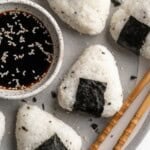
Onigiri
This vegan onigiri recipe tucks a chickpea tuna filling into seasoned sushi rice balls and wraps it up in nori. A perfect on-the-go snack!
Ingredients
- 400 g sushi rice/Japanese short grain rice
- 1 tablespoon furikake seasoning
- About ½ cup vegan chickpea tuna see note
- Water
- Sea salt
- Several strips of roasted nori
Instructions
- Place the sushi rice in a large bowl and cover with cold water. Gently swirl the rice with your hand, then drain the water. Repeat this process 3-4 times until the water runs clear. This step is essential to remove excess starch and prevent the rice from becoming too sticky.
- Transfer the washed rice to a rice cooker. Add the appropriate amount of water (refer to your rice cooker’s instructions, typically it’s a 1:1.25 ratio of rice to water). Let the rice cook until done.
- Once the rice has cooled slightly but is still warm, transfer it to a large bowl. Gently fold in the furikake seasoning, ensuring it's evenly distributed. Adjust the amount of furikake to taste.
- If you haven’t already made the vegan chickpea tuna, prepare it according to the recipe linked here. Ensure it's chilled before using it as a filling.
- Wet your hands with a little water and sprinkle with a pinch of sea salt. This prevents the rice from sticking to your hands and adds a bit of flavor. Scoop about 1-2 tablespoons of seasoned rice into your palm, then slightly flatten it to form a small patty. Place about 1 teaspoon of the vegan chickpea tuna filling in the center of the rice.
- Cover the filling with an equal amount of rice, then gently press and shape the rice into a triangle or ball, ensuring the filling is completely enclosed. Press firmly but gently to compact the rice without crushing it.
- Cut the roasted nori into strips (around 1/3 of the perforated strip found in most nori packages). Wrap a strip of nori around the bottom of each onigiri, pressing it slightly to adhere. The nori strip helps hold the shape of the onigiri and adds a nice flavor and texture.
- Repeat the process with the remaining rice and filling, adjusting the amount of filling and rice according to your preference. Serve the onigiri immediately, or wrap them individually in plastic wrap and store them in the refrigerator for up to a day.
Video
Notes
- Vegan Chickpea Tuna: This can be made in advance and stored in the refrigerator. It’s a flavorful and protein-rich filling that mimics the texture of traditional tuna.
- Furikake Seasoning: This Japanese seasoning blend typically contains sesame seeds, seaweed, salt, and sometimes dried fish or egg. Ensure you choose a vegan variety if required.
- Serving Suggestions: Onigiri can be enjoyed as a snack, part of a bento box, or as a light meal. They are great for picnics and lunchboxes.
- Storage: While onigiri are best enjoyed fresh, they can be stored in an airtight container in the refrigerator for up to 24 hours. The nori may lose its crispiness, but they will still be delicious.
- Nutrition: Nutritional information includes the rice only, not the filling.
Nutrition
Calories: 123kcal | Carbohydrates: 27g | Protein: 2g | Fat: 0.2g | Saturated Fat: 0.04g | Polyunsaturated Fat: 0.1g | Monounsaturated Fat: 0.1g | Sodium: 2mg | Potassium: 26mg | Fiber: 1g | Calcium: 4mg | Iron: 1mg